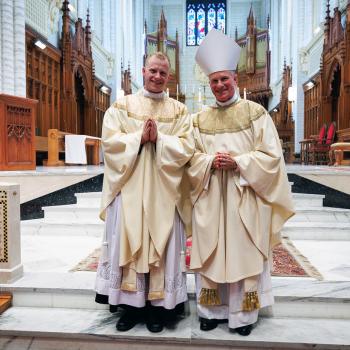The way the city has built up around the Ka'abah, which was originally constructed in a valley between surrounding hills, there is no way to get a view by accident. Furthermore, the mosque is now built around it and so you have to make your way through this mammoth elaborate and beautiful structure to get your glimpse.
You might see that mosque, Masjid al-Haram, but only after you have approached it by some distance. Especially the minarets, which are so high they shoot up taller than many of the buildings surrounding it. The hotels built around it, and a few administrative buildings, block the view at street level.
However, when you do see it, you will be required to complete the ritual performance: tawaf, followed as closely as possible after that with sa'iy.
My roommate and I decided with our late arrival, followed by breakfast, that we were not in our rooms soon enough to shower and rush out again, to make our umrah, without first resting. I was too excited to sleep for long, so I actually went out an hour earlier and began to scope the lay of the land. But I dared not approach the mosque too closely. Ever since that fajr debacle, I could not resist the pull the Ka'abah was having over me. We made our way to the mosque, leaving our hotel about a half hour before the time for zhuhr; it's only a 3-5 minute walk.
Now, I have to confess, maybe it was the glimpse of the mosque from our 7th-story hotel window, but I did NOT swoon, nor even shed a single tear when I looked beyond the pillars inside the mosque and first saw this incredibly plain box-like thing made of stone slabs. There was a black cloth draping the building, with a beautiful calligraphic design actually stitched in gold. But all I could think was, where is my WOW moment?
After praying our two rakaats, we stepped down into the inner court which surrounds the Ka'abah. We approached a line of people doing tawaf and fell into step. From the outer ring, this would be a pretty accurate description --falling into step, that is.
The tawaf is performed counter-clockwise, with the Ka'abah always on our left. At the corner that holds the black stone, the tawaf circuit begins. Here you are supposed to face the Ka'abah and hold both hands as high as your ears, with palms toward the black stone, and recite "bismi-Lah, Allahu Akbar laa ilaha illa-Allah." Then raise your right hand as if in greeting and bring it back to kiss. If you are close enough to the stone, you're supposed to kiss it. If you cannot kiss it, you should touch it with the right hand; if not, then just wave and kiss the hand. People also will touch it with an item of clothing and then kiss that, if they are close enough.
So we started our tawaf—this is possible from anywhere, but to "count" and complete the 7, we have to be opposite the corner with the black stone. For our first tawaf, we started a bit ahead and when we got to the black stone, we raised our hands and started our count. I was on the inside, closest to the Ka'abah and with each circuit or each corner, I attempted to move in closer and closer to the Ka'abah.
We were there at the heat of the day, but honestly with each and every corner, as we drew closer, the string from my heart was tugged just a little bit more taut, until I was overcome with the desire to get close enough to touch. It was such a strong feeling. I continued to recite my du'a labayk Allahuma labaykh, and to do zhikr. I chose to do so out loud instead of the silent version recommended for women. Wonder who came up with that?
In the thick of the stream of people making tawaf, this dhikr was really my saving grace. I almost never got overcome with anger or frustration. I was NOT focused on what the person, singular, was doing next to me. We were all a part of this mighty river, rushing round and around the Ka'abah, the House of God.
Nothing else mattered—well, except the roommate. We stayed linked at the arm until we hit the corner with the black stone. In order for me to wave, I had to get my arm out of her left arm link. I was conscious then not to get separated. But we managed the pause, the wave and kiss; and with each circuit, we got closer. Not surprisingly, the closer you get, the tighter the crowd is. What was a surprise was the more intense the current of the raging river of people became, the more pull on the heartstrings. Still with the dhikr on my lips, I swam the course and was at the same time pulled taut by the magnetic force of the Ka'abah and its attachment to my heart's string.
And that is when love struck me. I was in love with the Ka'abah. Somewhere between stepping foot into the inner courtyard that the Ka'abah is on and starting that first tawaf, I was stung, as if by mighty bee whose nectar was located inside the cube that seemed at first innocuous. I started smiling and continued to do so whenever I caught sight of the Ka'abah. It became the only thing that mattered, this crude structure established by the Prophet Abraham to commemorate the Oneness and Truth of God.




